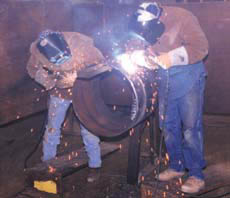Indoors or out, welders should try to clear the air
Date Posted: November 10 2000
Welding fumes are hardly a breath of fresh air.
That's why welders in the building trades workers are reminded to make sure the area in which they're working is well-ventilated - even if the area is outdoors.
"It is well known that fumes generated from arc welding operations expose welders and those around them to serious respiratory hazards," said a report from the Construction Occupational Health Program, out of the University of Massachusetts-Lowell. "This is pretty easy to see when a welding job is done in a shop or other indoor setting. If there is not adequate ventilation, the whole area quickly fills up with the familiar bluish gray fumes.
"However it is much harder to know when outdoor welders on construction projects are being exposed to fume hazards."
The reason: just because a welder is outdoors doesn't mean that ventilation is adequate. There are numerous instances where a welder could be working outdoors in a confined space, where fumes can easily accumulate.
Following are some safety tips welders should be aware of:
- Workers often assume that the wind will blow fumes away, but of course, there may not be any wind, or wind may create even a greater hazard in some areas by allowing fumes to accumulate in an eddy. When fumes are a hazard outdoors, workers should insist on personal protection equipment such as a respirator or blower.
- Welders should "work with the wind" when possible, and not get too close to the matter being welded.
- According to the Center to Protect Workers' Rights, there are numerous potential hazards associated with welding. Fumes and gases can deplete oxygen for the welder. Fumes from manganese, associated with red iron and carbon steel, can cause Parkinson's Disease.
- Zinc in galvanized metal or in paint (on welded surfaces) can cause metal fume fever. It feels like the flu and goes away in a few hours or days after exposure ends.
- The welding arc can form ozone and nitrous oxides from the air. MIG and TIG welding make the most ozone, most of all when aluminum is welded. These fumes irritate the eyes, ear, nose, throat, and lungs and can damage the lungs.
- Shortcuts may make life easier, but they're not always safer. Over the course of a construction career, not taking proper precautions when it comes to avoiding welding fumes can have an adverse affect on the respiratory system.

WHEREVER YOU'RE WELDING, inside or outside, maintain good ventilation or use personal respiratory equipment to make sure the purple haze of welding fumes don't wind up in your lungs.
